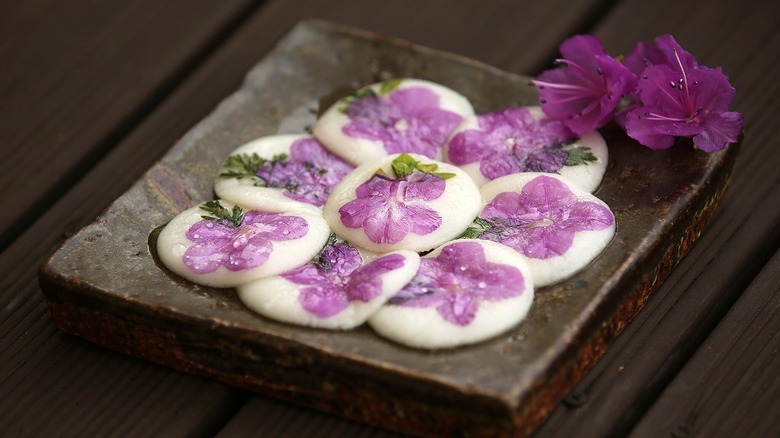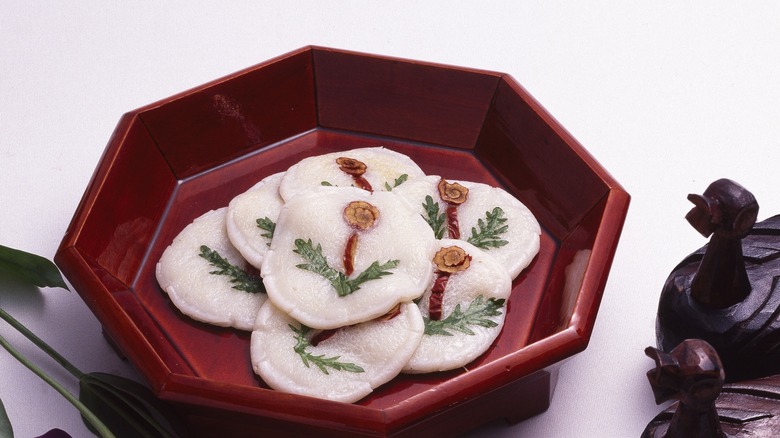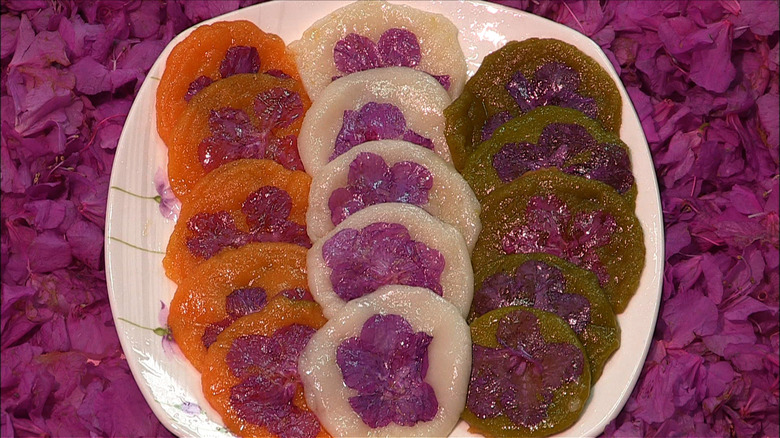Hwajeon, The Beautiful Fried Rice Cakes Decorated With Edible Flowers
Food is a multi-sensory experience — the visual appearance can make as much of an impression as the taste. Even if a component doesn't offer much subsistence, it can still be defining element of a dish. Who doesn't like a bit of eye-catching garnish?
Such is the case with hwajeon, a Korean fried rice cake garnished with flowers. A historic dish, this dessert has been prepared for hundreds of years since the Koryo dynasty, which lasted through the 14th century. Today, it continues to be popular during celebrations, especially ones interlinked with the lunar calendar. And its backstory is remarkable — it started as a food prepared by women foraging for flowers high up in the mountains.
Although involving only a few components, Hwajeon delivers a feast for the eyes. Plus, it tastes delicious and isn't too difficult to make. Not surprising it's so popular in Korean cuisine — let's dive into what it's all about.
How Hwajeon is made
Of course, the most immediately apparent aspect of hwajeon is the flowers. Most famously, the cakes are made with springtime azalea flowers; however, there are also other seasonal varieties. Rose petals are utilized in the summertime, while chrysanthemums are garnished in the fall. Many more renditions exist — if crafting at home, reach for any type of edible flower.
The preparation of hwajeon starts with the creation of a simple dough. The cakes are made with glutinous rice flour, which contributes to their unique texture. Despite its name, this milled flour made is actually gluten-free, and utilized in desserts like mochi and boba pearls for its sticky texture. The sweet rice flour is combined with a bit of salt and slowly mixed in with boiling water. Once it reaches a workable temperature and consistency, the dough is kneaded for a few minutes until smooth. The result is then divided into the desired number of small circles.
Next, the cakes are pan-fried in vegetable oil, and toasted for a few minutes until the exterior is crispy. At the end of the cooking process, the flowers are momentarily pressed into the cake but not fried to preserve the color. Once taken off the heat, a finishing drizzle of honey or simple syrup finishes the hwajeon.
How is Hwajoen served?
Traditionally, the fried rice cakes are served alongside a refreshing drink that infuses the same flowers into a honey-water, or omija-based tea. In accordance with the flowers used in the cakes, the companion beverage changes depending on the season. For example, in fall, when chrysanthemum hwajeon's are formed, the rice cakes are consumed alongside a chrysanthemum rice wine.
Hwajoen are interlinked with springtime festivities. Most prominently, they're enjoyed on March 3rd, an important date in the lunar calendar. Eaten at picnics called hwajeon nori, the cakes are prepared by women in the mountains. The flowers are picked on the mountainside, and the cakes fried on pans carried to the lofty elevation.
However, consumption of hwajoen is not limited to only one holiday. The rice cakes are also made on Buddha's birthday, and other Korean holidays. With such a colorful appearance, it's no surprise the cakes have such a festive association — every batch feels like a celebration.


